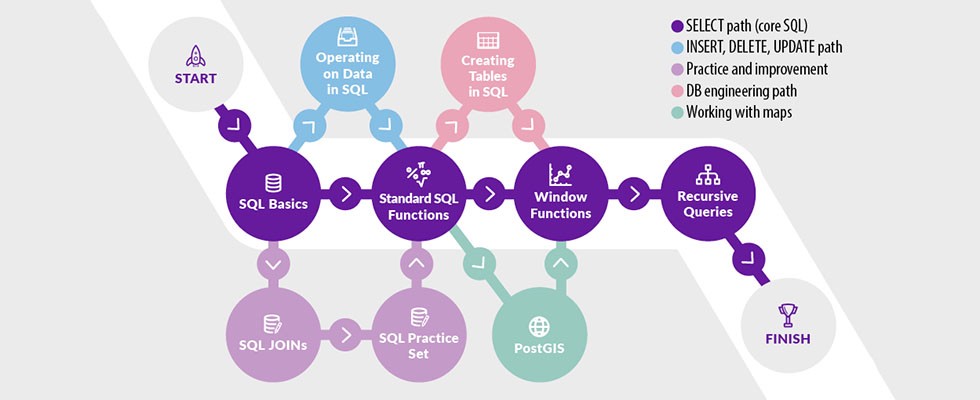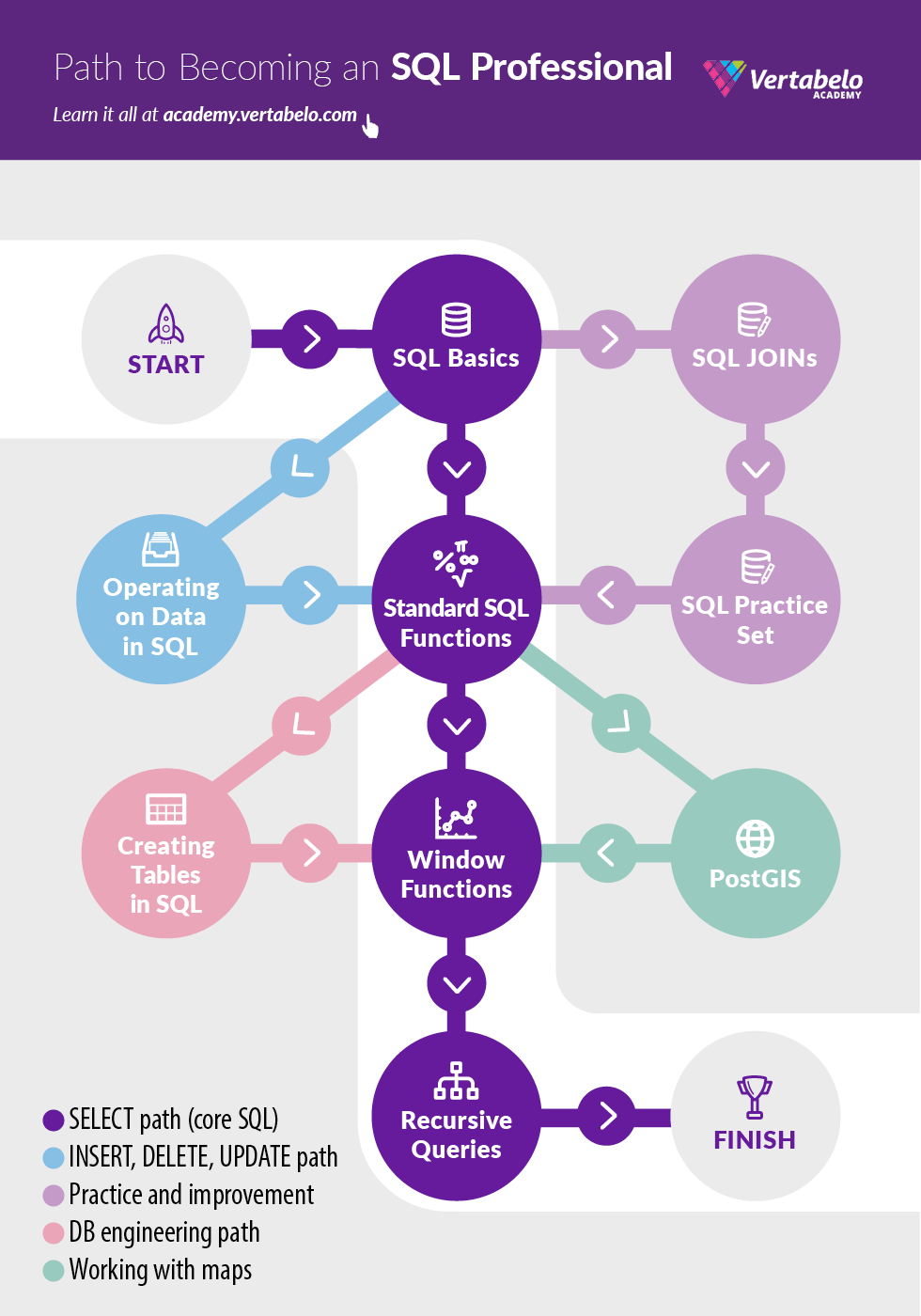Path to Becoming an SQL Professional on Vertabelo Academy

So you want to learn SQL and decided to learn with Vertabelo Academy? That's great! This article show you the sequence in which to take the courses in order of increasing difficulty.
Courses Teaching Standard SQL (ANSI)
If you plan to begin learning SQL and would like to become a professional, your first step is to complete the SQL Basics course. This is the fundamental course that will provide a smooth introduction to the world of relational databases by learning about tables. You'll learn how to SELECT data from specific tables, how to filter and sort the records, and how to get the hang of the most famous SQL clause: the JOIN. At the end of the course you'll also see a snippet of more advanced issues like subqueries, aggregate functions, and operating on sets.
SQL Basics can optionally be followed by the course on SQL JOINs and then with the SQL Practice Set. It's not a must-have, but these courses help you practice what you've learned in the SQL Basics course. From the SQL Basics course you will be familiar with how to build simple queries to get data from a single table and with the basics of joining more than two tables. In the SQL JOINs course you extend your knowledge about joining tables. You will learn which type of a JOIN operation to use in a specific situation, how to join one table to another through key or non-key columns, and in what situations it is worthwhile to use a self-join query. The skills acquired from these two courses will allow you to write queries based on data stored in more than one table. To reinforce what you have learned, you can test your basic knowledge with the SQL Practice Set. This course contains 88 interactive exercises from simple to advanced and has a special challenge at the end.
OK, now you're ready for the next step: taking the Standard SQL Functions course where you will learn how to use text functions, numeric functions, and how to operate on dates and time. You will get a chance to learn about CASE WHEN structures and about the use of NULL in SQL functions.
Psst! At this step of your SQL education (after completing the Standard SQL Functions course), you're ready to learn about how to manipulate data. In the Operating on Data in SQL course you discover how to INSERT data into a table, how to UPDATE a table, and how to DELETE data from a table. You will also learn how to use default values defined in columns. Again, this course is not a must-have but it's a good extension for people interested in exploring more about INSERT, DELETE, and UPDATE. This course takes you about 2 hours, the shortest course in the series.
You will find out more about standard functions from another course: Window Functions. It is material that presents window functions, which are used mainly in reports. You will learn how to build complex aggregations using OVER, ORDER BY, and PARTITION BY. The final, and most challenging, course is on Recursive Queries. In this course you will obtain knowledge about how to write complex queries in an easier way. You will find out about what Common Table Expressions (CTEs) are, how to create nested and recursive CTEs, and how use CTEs with the INSERT, UPDATE and DELETE statements.
The steps in the SQL standard path to become an expert are mapped out below:
SQL Courses Teaching SQL Server (T-SQL)
In Vertabelo Academy, we not only teach standard SQL, but we also have courses teaching Transact-SQL (T-SQL) that works with SQL Server. The SQL Basics in MS SQL Server course should be taken first. This course teaches the fundamentals of T-SQL with subqueries and operating on sets. A good choice for a second course would be Common Functions in MS SQL Server, and a third would be Window Functions in MS SQL Server. The next step should be the course GROUP BY extensions in MS SQL Server, where you'll learn how to write queries with the ROLLUP, CUBE, and GROUPING SETS extensions for GROUP BY, available in SQL Server for creating advanced reports. Last but not least for T- SQL courses offered by Vertabelo Academy is Recursive Queries in MS SQL Server. Note that most of these courses (except the GROUP BY extensions in MS SQL Server) are almost the same as courses in standard SQL, they just additionally cover extensions available only in Sql Server.
Bonus Courses:
If you're interested in a database administration career and have obtained basic skills in SQL, complete the Creating Tables in SQL course. You will learn how to build a relational database, how to create tables and alter them, why and how to define a primary key, a foreign key, and constraints for a table. You will also find out how to use DROP TABLE to remove a table from a database and when to use views. This course won't teach you how to SELECT data from a database but how to build the structure of the database. Please note that in order to complete the Creating Tables in SQL course, you need to first complete the SQL Basics and Standard SQL Functions courses.
Wrap-up
By learning about standard SQL you can work in any SQL database, like PostgreSQL, SQL Server, MySQL, etc. These database servers only expand SQL with other features that are specific to them. However, if your favorite relational database server is SQL Server, you can start learning T-SQL right away.
This article presents what sequence of courses should be taken to become an SQL expert. Don't worry, even if you are an absolute novice you can start learning SQL today, because our courses are designed to be understandable for any level of technical skills. Start learning today and don't forget to visit our blog again!






